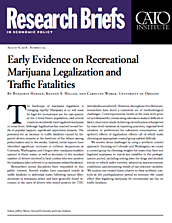The landscape of marijuana regulation is changing rapidly. Marijuana is or will soon be legal for recreational use for one-quarter of the United States population, and several countries worldwide have legalized marijuana in some form. Although legalization has reached record levels of popular support, significant opposition remains. The potential for an increase in traffic fatalities caused by impaired drivers remains at the forefront of the debate among policymakers and in the media. Indeed, initial reports have identified significant increases in collision frequencies in Colorado, Washington, and Oregon after marijuana markets opened in those states, as well as increases in the nominal number of drivers involved in fatal crashes who test positive for marijuana (also referred to as marijuana-related fatalities).
Researchers across disciplines have responded to this public interest. Several studies have examined trends in traffic fatalities in individual states following various liberalizations in marijuana policy and have generally found increases in the rates of drivers who tested positive for THC (tetrahydrocannabinol). However, throughout this literature, researchers have faced a consistent set of methodological challenges. Contemporaneous trends in the state-level price of, and demand for, intoxicating substances make it difficult to find a clean event study. Achieving identification is hampered by state-level variation in reporting practices, regional-level variation in preferences for substance consumption, and spillover effects of legalization efforts — all of which make choosing an appropriate control group a priori difficult.
We resolve those challenges by using a synthetic control approach. Focusing on Colorado and Washington, we create a control group by choosing weights for states that have not legalized marijuana to match key variables in the prelegalization period, including testing rates for drugs and alcohol, trends in vehicle miles traveled, urbanicity, macroeconomic conditions, and preexisting trends of our outcome variables. We analyze our treated states relative to their synthetic controls in the postlegalization period to estimate the causal effect that legalizing marijuana for recreational use has on traffic fatalities.
We find that, since legalizing marijuana, Colorado and Washington have not experienced significantly different rates of marijuana- or alcohol-related traffic fatalities relative to their synthetic controls. To ensure that our results are not driven by an idiosyncratic selection of control weights, we show that we obtain similar results across reasonable variations in the preperiod specification used to create the weights that generate the synthetic control counterfactual. In addition to examining fatalities identified by states as drug- or alcohol-related, we also look for changes in the overall fatality rate to avoid state-level differences in classification (as opposed to state-level differences in testing) and find a similar null result.
Several mechanisms may be driving these results. The amount of marijuana sold in recreational stores has grown dramatically, increasing from 3,991 pounds in Washington in 2014 to 179,301 pounds in 2017, while in Colorado it grew from 36,031 pounds in 2014 to 102,871 pounds in 2016. However, it is difficult to discern how much of that growth in legal recreational marijuana came at the expense of sales in blackmarket or medical marijuana. Indeed, recreational marijuana can be viewed as a close substitute to black-market or medical marijuana, with differences in price, quality, and ease of access. The relatively small effects we estimate are consistent with a story of the legal market crowding out the illegal market, and they could explain why we don’t observe spillover effects on alcohol-related traffic accidents as other studies have found. It is also possible that marijuana impairment may be associated more with nonfatal accidents and property damage than, for example, alcohol impairment is.
Although our results suggest that the marijuana legalization in Colorado and Washington did not cause discernible increases in traffic fatalities, estimating the externalities of marijuana abuse and driving while high is still crucial in determining future policy. Indeed, Colorado has recently chosen to allow the consumption of marijuana in public spaces, which may increase the potential for negative externalities. Whereas Colorado and Washington have set the legal limit for driving while high at 5 nanograms of THC per milliliter of blood, we don’t yet know if the sanctions for driving while high will be effective in discouraging that behavior given the local population of drivers affected by that threshold. Furthermore, there is still ample debate about what the right legal threshold would be and whether the threshold should even be based on THC. Although the use of blood alcohol content is common today for measuring impairment in drunk driving, it took decades of research and innovation from the passage of the first drunk driving laws to the creation of the first Breathalyzers. Science and policy alike are playing catchup in measuring both the incidence and the relative risks of driving while high.
NOTE
This research brief is based on Benjamin Hansen, Keaton S. Miller, and Caroline Weber, “Early Evidence on Recreational Marijuana Legalization and Traffic Fatalities,” NBER Working Paper no. 24417, March 2018, http://www.nber.org/papers/w24417.
About the Authors

This work is licensed under a Creative Commons Attribution-NonCommercial-ShareAlike 4.0 International License.
